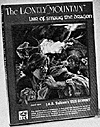
Designed by Coleman Charlton
Iron Crown Enterprises
PO. Box 1605, Charlottesville, VA
22902
Released: January, 1985
Catalogue No: FR7300
Price: $18.00
Complexity. Beginner to
Intermediate
Solitaire Suitability: Good
* * * 1/2
The Lonely Mountain (LM) depicts a possible raid on Smaug's lair after the giant dragon wrested it from the Dwarves, but before the visit by Bilbo and his Dwarven cohorts. It is the third board game in Iron Crown Enterprises' series of Middle-earth releases. Smaug and 36 other creatures guard hoards scattered throughout the mountain's interior, and each player is responsible for one hand of brave, but foolhardy adventurers out to relieve the mountain of a portion of its treasure. The object isn't to confront Smaug, but rather to steal and get out alive. Foolhardy the adventurers may be, but stupid they aren't.
LM comes with an impressive set of components. There is an 18 X 24 inch full color game map, a separate 17 X 23 inch monster, treasure, and information display, a 12-page rule book, 216 punchout Character, Creature, and Treasure cards, 80 half inch counters, and 2 dice. The rule book actually contains two sets of rules, one for the introductory game and one for the standard game.
I enjoy playing LM, although this is one of those games that would play much more smoothly with hidden movement and a computer. It is a good simulation of the type of raid it depicts, but play balance and simplicity sometimes require arbitrary and baffling rules. Creatures which would be better off to stand and fire missiles are still required to close and melee whenever possible.
There is a set of optional rules which help smooth out some of this awkwardness. One of the best of these is the rule which turns over control of the creatures except Smaug to an extra player. It should probably be used even when there are just two or three players. Beef up the character parties if you find them too weak in comparison.
In particular, LM is well suited to solitaire play, something the folks at Iron Crown Enterprises don't emphasize at all in the rule book. Even given the annoyance of sometimes silly behavior, the monsters of Lonely Mountain provide formidable opposition just by following the simple rules laid out for them. Surviving the creatures and escaping with any significant treasure is quite a challenge by itself. In fact, I find that multiple-player LM usually resolves itself as a set of simultaneous solitaire games, with each party having more than enough trouble with creatures to worry about what anyone else is up to.
The rule book, as I mentioned, is divided into an introductory and a standard game. The introductory game is geared for beginning gamers, and does a very good job of defining its terms and expressing -itself clearly. The standard game, designed for more experienced gamers, is a better simulation, although there is, as would be expected, some overlap between the two sets of rules.
This overlap causes some of my biggest problems with LM. There are many small differences between the two sets of rules, and the rule book makes little effort to emphasize these differences. A straight-through reading of the standard rules might help, except that they continually refer to the introductory rules. Players trying to advance from the introductory to the standard game are likely to have to play five or ten times before they have flushed out all of the changes in the more advanced rules.
The standard rules have a few problems. Most of these occur when trying to define terms which disregard reality but which are included for play balance. For example, the sentence, "A creature may not be attacked unless it is active," is followed two paragraphs later hy, "Any creature attacked by a group is automatically activated."
Given that most of the problems in LM involve untangling the rules, it is definitely a game which improves each time you play. There are a number of possible strategies, often depending on the character race you're playing: Man, Elf, Dwarf, Orc, or Freebooter. in all cases, the questions of where Smaug is lurking and who will stumble across him and his hoard first, lead to tremendous daring in exploration. Smaug is appropriately awe-inspiring, but I question whether he would have ever let any other creature look after part of his treasure, especially non-Tolkien creatures like kraken and giant snakes. Lonely Mountain, however, would be pretty monotonous with only one hoard and one dragon guarding it.
Lonely Mountain has possibilities as an introduction to gaming for Tolkien fans. More especially, though, I recommend it to any experienced group of fantasy gamers who can trust each other enough to get rid of the arbitrary rules enforcing fair play. If you trust your opponent, you don't have to know the analysis of the potion he just found, or what creature he's fighting half a mountain away from you. Using the optional rules and adjusting LM to suit your particular interpretation of Middle-earth reality can make a raid on Lonely Mountain a dangerous but rewarding endeavor.
More Adult Game Reviews
-
Game Review: Mhing
Game Review: The Ungame: Pocket Size Version
Game Review: The Lonely Mountain Lair of Smaug the Dragon
Game Review: Power Trip: For Kinetic Intellects
Back to Table of Contents -- Game News #7
To Game News List of Issues
To MagWeb Master Magazine List
© Copyright 1985 by Dana Lombardy.
This article appears in MagWeb (Magazine Web) on the Internet World Wide Web.
Other military history articles and gaming articles are available at http://www.magweb.com